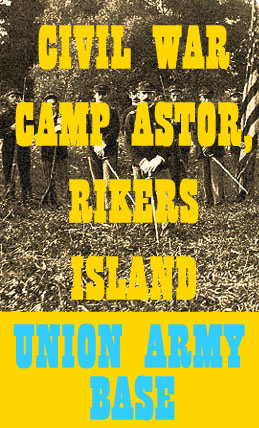
 |  |
[Continued from Page 43 above:]
an alarming extent, while there was no proper hospital in which to treat it. the Club
provided floors for the tents, and small stoves for each. It also built a building to serve as
a hospital .... Click on the above image for more on the Union League Club and its history.
This image and caption do not appear in printed book and have been added to the web version by the NYCHS webmaster. From the summer of 1864 to September of that year the commandant of the
Riker’s Island operation was Brigadier General Nathaniel James Jackson who served
throughout the war. He started as colonel of the 1st Maine Militia regiment and
ended as a breveted major general. During his service he was charged with the
“draft rendezvous” on Riker’s Island and subsequently on near-by Hart’s Island. By
as early as the end of the year the use of the island changed when it reportedly
became a prisoner - of - war camp, although if the example of Hart’s Island is relevant,
it was in 1865 close to the end of the war that it became such. Hart’s [Island] in several
months’ time had a total of about 3100 prisoners of, whom about 230 died in
confinement. The indicated percentage of deaths was below the average for all
camps, but considering the very short time of its existence its death rate far exceeded
even that of the infamous Andersonville prison.
“Within a short time (i.e. either in
very late 1864 or early 1885) barracks were built for the guard and Confederate
prisoners were moved onto the island. Water was eventually supplied by cisterns
filled with runoff water from the roofs.” [Quoting from Portals to Hell: Military Prisons of the Civil War by Lonnie R. Speer.]
Whether the conditions subsequently in
the Riker’s Island camp were as bad as those on Hart’s Island apparently were, and
whether there was a comparable death rate, has not been discovered. Official records
pertaining to this use of Biker’s Island have not been located in either federal or
state agencies, but the proposal for it came much earlier in a letter part of which is
as follows:
DECEMBER 12, 1863.
SIR: I have the honor to submit the following report of an inspection which I have just
made, pursuant to your instructions, for forts on the eastern seaboard, with a view
to selecting such ones as may be suitable for the confinement of prisoners of war . . .
For some tune past there has been a camp on Riker’s Island, which is in the East River
between the city and Fort Schuyler; but the camp is about being transferred
to another island, and it offers an excellent location for a place of confinement for
prisoners of a special character, which at this time is much needed.
We have officers
under special charges, blockade runners, piratical cases, political prisoners, and women,
all of whom should be kept separate from ordinary prisoners of war and from each other,
and I respectfully recommend that a suitable prison be erected on this island
of sufficient extent to receive 1,000 prisoners and so arranged as to be capable of
enlargement if necessary.
There are but two or three buildings on the island, which
are now used as store-houses. I am informed by Major Van. Vliet that it costs about
$25 per man to erect barracks for soldiers in the vicinity of New York. A prison may,
therefore, be expected to cost $25,000 to $30,000. Water is scarce upon the island,
[In printed book, the text continues on Page 45.]
|
home page |
USCTs |
Civil War letters | Civil War prisons |
terrorists in NYC |
|
| ||||